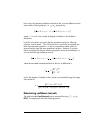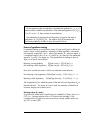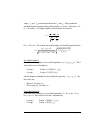
Page 18-35
Hypothesis testing
A hypothesis is a declaration made about a population (for instance, with
respect to its mean). Acceptance of the hypothesis is based on a statistical test
on a sample taken from the population. The consequent action and decision-
making are called hypothesis testing.
The process of hypothesis testing consists on taking a random sample from the
population and making a statistical hypothesis about the population. If the
observations do not support the model or theory postulated, the hypothesis is
rejected. However, if the observations are in agreement, then hypothesis is not
rejected, but it is not necessarily accepted. Associated with the decision is a
level of significance α.
Procedure for testing hypotheses
The procedure for hypothesis testing involves the following six steps:
1. Declare a null hypothesis, H
0
. This is the hypothesis to be tested. For
example, H
0
: μ
1
-μ
2
= 0, i.e., we hypothesize that the mean value of
population 1 and the mean value of population 2 are the same. If H
0
is
true, any observed difference in means is attributed to errors in random
sampling.
2. Declare an alternate hypothesis, H
1
. For the example under consideration,
it could be H
1
: μ
1
-μ
2
≠ 0 [Note: this is what we really want to test.]
3. Determine or specify a test statistic, T. In the example under consideration, T
will be based on the difference of observed means, ⎯X
1
-⎯X
2
.
4. Use the known (or assumed) distribution of the test statistic, T.
5. Define a rejection region (the critical region, R) for the test statistic based on
a pre-assigned significance level α.
6. Use observed data to determine whether the computed value of the test
statistic is within or outside the critical region. If the test statistic is within the
critical region, then we say that the quantity we are testing is significant at
the 100α percent level.


















